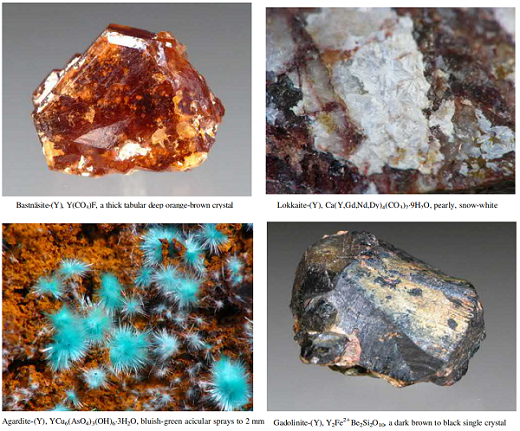Which rare-earth minerals contain Yttrium?
May 29,2024
Introduction
Yttrium is found in most rare-earth minerals; it is found in some uranium ores but is never found in the Earth’s crust as a free element. The Earth’s crust contains about 31 ppm yttrium, making it the 28th most abundant element, about 400 times more common than silver. Since Y is chemically similar to the lanthanides, it occurs in the same ores (rare-earth minerals) and is extracted by the same refinement processes. It has 39 electrons arranged in an electronic configuration of [Kr]4d1 5s2. Its chemistry concerns the formation of a predominantly ionic 13 oxidation state arising from the loss of two electrons from the 5s subshell and one electron from the 4d subshell.
Yttrium isotopes are among the most common products of uranium nuclear fission in nuclear explosions and nuclear reactors. In the framework of nuclear waste management, the most significant isotopes of yttrium are 91Y and 90Y, with half-lives of 58.51 days and 64 hours, respectively. Yttrium has only a single stable isotope, 89Y, which is also the only naturally occurring isotope. 89Y is believed to be more abundant than it otherwise would be, due in part to the s-process, which allows sufficient time for isotopes formed by other processes to decay by electron emission (essentially, a neutron becomes a proton while an electron and antineutrino are emitted).
Preparation
One process to produce pure yttrium from the mixed oxide ores is to dissolve the oxide in sulfuric acid and fractionate it by ion-exchange chromatography. After the addition of oxalic acid, yttrium oxalate is precipitated. The oxalate is subsequently converted into the oxide by heating under oxygen. The reaction of the resulting yttrium oxide with hydrogen fluoride produces yttrium fluoride. When quaternary ammonium salts are utilized as extractants, most of the yttrium will stay in the aqueous phase. When the counter-ion is nitrate, the light lanthanides are removed; when the counter-ion is thiocyanate, the heavy lanthanides are removed. In this manner, yttrium salts of 99.999% purity are produced.
Minerals

About a hundred different minerals are known to contain Y in their crystal structure.
Three halides are known to contain Y, chukhrovite-(Y) (Ca3(Y,Ce)[F|SO4|(AlF6)2]· 10H2O), gagarinite-(Y) (NaCaYF6), and tveitite-(Y) ((Y, Na)6Ca6Ca6F42).
In the oxide class, more than 25 minerals are known to have Y in their crystal structure, for example, euxenite-(Y) ((Y, Ca, Ce, U, Th)(Nb, Ta, Ti)2O6), fergusonite-(Y) (YNbO4), polycrase-(Y) (Y(Ti, Nb)2(O, OH)6), samarskite-(Y) (YFe3+Nb2O8), and yttriaite-(Y) (Y2O3).
About 20 minerals are found in the ate class containing Y, such as adamsite-(Y) (NaY[CO3]2· 6H2O), bastnasite-(Y) (Y(CO3)F), lokkaite-(Y) (Ca(Y, Gd, Nd, Dy)4(CO3)7· 9H2O), and synchysite-(Y) (CaY(CO3)2F). One borate is known, moydite-(Y) (Y[B(OH)4](CO3)). The sulfate class includes two minerals with Y, paraniite-(Y) (Ca2Y(AsO4)(WO4)2) and sejkoraite-(Y) (Y2(UO2)8(SO4)4O6(OH)2· 26H2O).
Nine different phosphate class minerals are known to have Y in their crystal structure, for example, agardite-(Y) (YCu6(AsO4)3(OH)6. 3H2O), churchite-(Y) (Y(PO4). 2H2O), and xenotime-(Y) (Y(PO4)).
The largest group of about 40 minerals containing Y is found in the silicate class, such as allanite-(Y) ({CaY}{Al2Fe2+}(Si2O7)(SiO4)O(OH)), gadolinite-(Y) (Y2Fe2+Be2Si2O10), and yttrialite-(Y) ((Y, Th)2Si2O7). A single organic compound exists, levinsonite-(Y) ((Y,Nd,La)Al(C2O4)(SO4)2·12H2O), with Y in its structure.
- Related articles
- Related Qustion
The abundance of barium is 0.0425% in the Earth’s crust. The main commercial source of barium is baryte (also called barite, barytes or heavy spar, BaSO4) with deposits in numerous parts of the world.....
May 29,2024Inorganic chemistryTin is the 49th most abundant element in Earth's crust, which is often found in nature as mineral. This article will introduce its distribution around the world.....
May 29,2024Inorganic chemistryYTTRIUM
7440-65-5You may like
- The niobium oxide nanomaterials
Jul 4, 2024
- Rhenium:Discovery,Minerals,Chemistry,Uses,Toxicity
May 31, 2024
- How are Lead Minerals Distributed?
May 31, 2024




